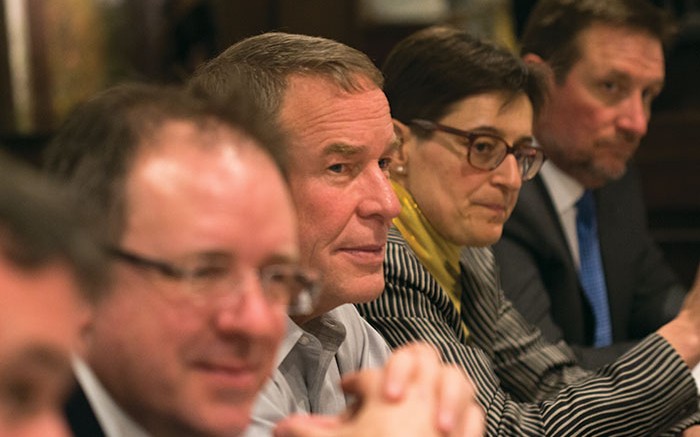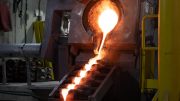Industry leaders weighed in on whether the mining sector has performed poorly on its return on investment (ROI), and what can be done about it, at The Northern Miner’s roundtable discussion in Toronto in mid-January. The roundtable — sponsored by PwC and moderated by Northern Miner publisher Anthony Vaccaro — augments the Miner’s independent research on the topic, which will be published in early March.
Results from our survey on ROI show that 71% of respondents share the impression that mining ranks worse than the average of all sectors of the economy, while 52% of those polled agree or strongly agree that an overabundance of capital entering the mining industry in the mid-2000s led to development of lower-quality projects that wound up driving down ROI in the sector.
President and CEO of Goldcorp (TSX: G; NYSE: GG) Chuck Jeannes kicked off the roundtable discussion by noting that during the last bull market the industry — including Goldcorp — “chased ounces” and “allowed cut-off grades to decline just about as fast as the gold price was going up,” which lifted costs per ounce. Over 10 years, he added, the “compound annual growth rate (CAGR) of the gold price was 16% and the CAGR of the cost was 15%, and so that’s what happened to our margins.”
Rob McEwen, founder and executive chairman of McEwen Mining (TSX: MUX; NYSE: MUX), pointed out that current capital constraints are imposing “discipline to the market,” after financiers and investment dealers “seduced the industry into believing there was an endless supply of money, and they’d give it to you on a handshake, almost, and you’d go build.” Companies then built bigger and bigger operations with a lot of moving parts that could be easily delayed, throwing projects off schedule and budget.
Andrew Cheatle, executive director of the Prospectors & Developers Association of Canada, said that investors see the mining industry as high risk.
“And the fact of the matter is, we are high risk. Some of our studies, for example, show that if you take 100 companies over 10 years, only 22 of those will give you a positive return on your investment,” he noted, adding that those that do can offer “massive” returns. For discerning where to invest, “you have to go back to fundamental issues … [and] underlying geology,” and whether the company and project offers “flexibility.”
As moderator, Vaccaro asked whether the mining industry suffers from a lack of innovation and new technology, and the kind of management “disruptors” seen in a number of other industries, such as Elon Musk, who has turned conventional thinking on its head with his rockets, fintech and electric cars.
Responses were mixed. Some, like Geoff Burns, director of Pan American Silver (TSX: PAA; NASDAQ: PAAS), said the mining industry has incorporated technology on a wider scale than it gave itself credit for and adopetd it incrementally, pointing to computer control-systems and guidance and fuel-control systems as examples. He argued that “there hasn’t been any revolutionary technology adapted specifically to mining,” adding that the oil and gas industry has a lot more money to spend on research and development than the mining industry does.
Catharine Farrow, CEO of TMAC Resources (TSX: TMR), said there have been a few advances in metallurgical processes — some as simple as froth cameras — and noted that her company might put a concentrator completely underground at its Hope Bay gold project in the Arctic.
Doug Pollitt, an analyst at Pollitt & Co., added that while much of newest tech in mining “hasn’t been that sexy,” there has been a lot of technology adapted in the industry, such as optimized dispatch systems and GPS on the end of shovels, which help operators selectively mine pits and benches.
Others, like Jeannes and McEwen, disagreed.
“Sorry, we’re doing tele-remote skips and automated haulage and scoops now, but the technology has existed to have an entirely 100% automated underground mine for 20 years, and nobody’s done it — nobody,” Jeannes said. “Every time we go to find a new mine manager or a new technical services manager, we look for the greyest hair, the one that has the most experience, the one that has built six other mines just like this, rather than someone who may have a new idea.”
McEwen added that “if you look at the technology industry, they’re innovating all the time, and they don’t have long-life duration on their products.”
Jason Neal, managing director and global co-head for BMO Metals & Mining Group, said that from a banker’s perspective, when companies go out to raise money and put together initial public offering presentations, one thing they try to do is show that everything about the project is completely conventional and therefore lower risk.
Calum Semple — partner and global mining consulting leader at PwC, who crossed over to mining from the manufacturing sector — argued that mining is a “fundamentally a process industry” and that while you can’t change what’s in the ground or the market price, you can change everything else.
“There’s so much to be learned from energy and manufacturing,” he said. “Mining to me is where manufacturing was in the late eighties.”
Chris MacIntyre, vice-president of corporate development at Reservoir Minerals (TSXV: RMC; US-OTC: RVRLF), said the industry “doesn’t take in young people,” citing Queen’s University, which may graduate about 120 mining engineers this year. “How many jobs are they going to get? Four? Five? … they’re going to be driving buses for the City of Kingston … there needs to be a better way of bringing these people into the business in different ways.”
TMAC’s Farrow emphasized the need to widen the talent pool by creating a corporate culture that welcomes more young people, aboriginal employees and women.
According to Pollitt, one of the things that make it tough to provide a decent ROI in the gold sector, is its small size in relation to the capital flows that see it as an asset class unto itself. “When the asset comes into favour, there’s more money than there are available opportunities where returns are available at the margin,” he said. “Money doesn’t sleep, it’s got to go somewhere. And so it goes into suboptimal market opportunities.” Pollitt noted that “over a long enough time frame, if you look at cash in versus cash out, gold mining has been disappointing — certainly since 1980.”
Pan American Silver’s Burns emphasized that it’s tough for miners to invest in research and development, or continue to invest in exploration, when they are dealing with volatile commodity prices, which in the case of silver, has plunged from US$35 per oz. in 2013 to US$14 per oz. today. “Have you ever seen a Starbucks coffee go from $1.95 to 70¢? It doesn’t happen.” He added that “we all sinned when prices went up, but the reality is that if prices were higher now, we wouldn’t be sitting around this table talking about ROI.”
BMO’s Neal said that many mining acquisitions were made at the high point in the market and paid for with cash rather than shares. “When you put cash in an acquisition, it turns it from a relative exercise into an absolute exercise … you’re betting on a commodity price because you’re changing your capit
al structure at the same time … then you put it on your balance sheet … and you go from US$1,800 gold to US$1,100 gold. You’re never going to generate a return on what was there.”
In addition to using conventional metrics like ROI in a cyclical industry like mining where commodity prices can swing wildly, Neal and others remarked on the shorter time horizons often used in evaluating projects by institutional and retail shareholders compared with boards and management teams, while Pollitt mused on gold miners impacting their end price, rather than being “price-takers.”
McEwen noted the barrier to entry in mining isn’t always high, and that “you have a lot of entrants at various points when money is plentiful, and so you’ll get this boom-and-bust type of mentality.” He raised the issue of disappearing members of the investment community, adding that “most of the analysts right now are hiding under rocks … they don’t want to look at anything other than cash flow.”
David Smith, Agnico Eagle Mines’ (TSX: AME; NYSE: AEM) senior vice-president of finance and chief financial officer, stressed the importance of maintaining exploration during down times.
PwC’s Semple said that a good management team in any industry is hard to find, but it’s even harder in mining, given the sector’s commodities mix, geography and mining methods. “There are a ton of mining companies out there that frankly don’t have good management teams,” he said. “You could give a lot of management teams a good portfolio of assets to manage, and I guarantee you that before the market turns again, they’ll drive that through the floor.”
He says many miners have not prepared for the next generation of leaders. “When you look at the good management teams, they haven’t all done a great job on succession … so what’s next?”





Be the first to comment on "TNM Roundtable: Leaders debate industry’s return on investment"